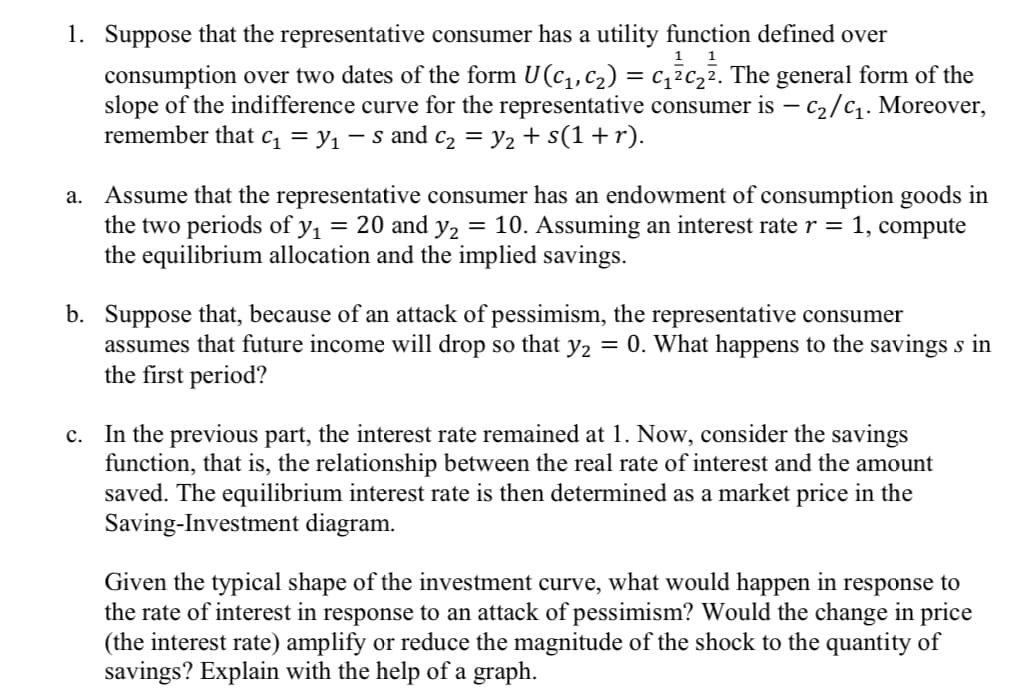1. Suppose that the representative consumer has a utility function defined over 11 consumption over two dates of the form U(C₁, C₂) = C₁zc₂2. The general form of the slope of the indifference curve for the representative consumer is - C₂/C₁. Moreover, remember that c₁ = Y₁ - S and C₂ = y₂ + s(1 + r). Assume that the representative consumer has an endowment of consumption goods in the two periods of y₁ = 20 and y₂ = 10. Assuming an interest rate r = 1, compute the equilibrium allocation and the implied savings. b. Suppose that, because of an attack of pessimism, the representative consumer assumes that future income will drop so that y₂ = 0. What happens to the savings s in
1. Suppose that the representative consumer has a utility function defined over 11 consumption over two dates of the form U(C₁, C₂) = C₁zc₂2. The general form of the slope of the indifference curve for the representative consumer is - C₂/C₁. Moreover, remember that c₁ = Y₁ - S and C₂ = y₂ + s(1 + r). Assume that the representative consumer has an endowment of consumption goods in the two periods of y₁ = 20 and y₂ = 10. Assuming an interest rate r = 1, compute the equilibrium allocation and the implied savings. b. Suppose that, because of an attack of pessimism, the representative consumer assumes that future income will drop so that y₂ = 0. What happens to the savings s in
Chapter4: Utility Maximization And Choice
Section: Chapter Questions
Problem 4.11P
Related questions
Question

Transcribed Image Text:1. Suppose that the representative consumer has a utility function defined over
consumption over two dates of the form U(C₁, C₂) = c₁²c₂². The general form of the
slope of the indifference curve for the representative consumer is - C₂/C₁. Moreover,
remember that c₁ = y₁ − S and C₂ = y₂ + s(1 + r).
a. Assume that the representative consumer has an endowment of consumption goods in
the two periods of y₁ = 20 and y₂ = 10. Assuming an interest rate r = 1, compute
the equilibrium allocation and the implied savings.
b. Suppose that, because of an attack of pessimism, the representative consumer
assumes that future income will drop so that y₂ = 0. What happens to the savings s in
the first period?
c. In the previous part, the interest rate remained at 1. Now, consider the savings
function, that is, the relationship between the real rate of interest and the amount
saved. The equilibrium interest rate is then determined as a market price in the
Saving-Investment diagram.
Given the typical shape of the investment curve, what would happen in response to
the rate of interest in response to an attack of pessimism? Would the change in price
(the interest rate) amplify or reduce the magnitude of the shock to the quantity of
savings? Explain with the help of a graph.
Expert Solution
This question has been solved!
Explore an expertly crafted, step-by-step solution for a thorough understanding of key concepts.
This is a popular solution!
Trending now
This is a popular solution!
Step by step
Solved in 2 steps with 1 images

Knowledge Booster
Learn more about
Need a deep-dive on the concept behind this application? Look no further. Learn more about this topic, economics and related others by exploring similar questions and additional content below.Recommended textbooks for you



